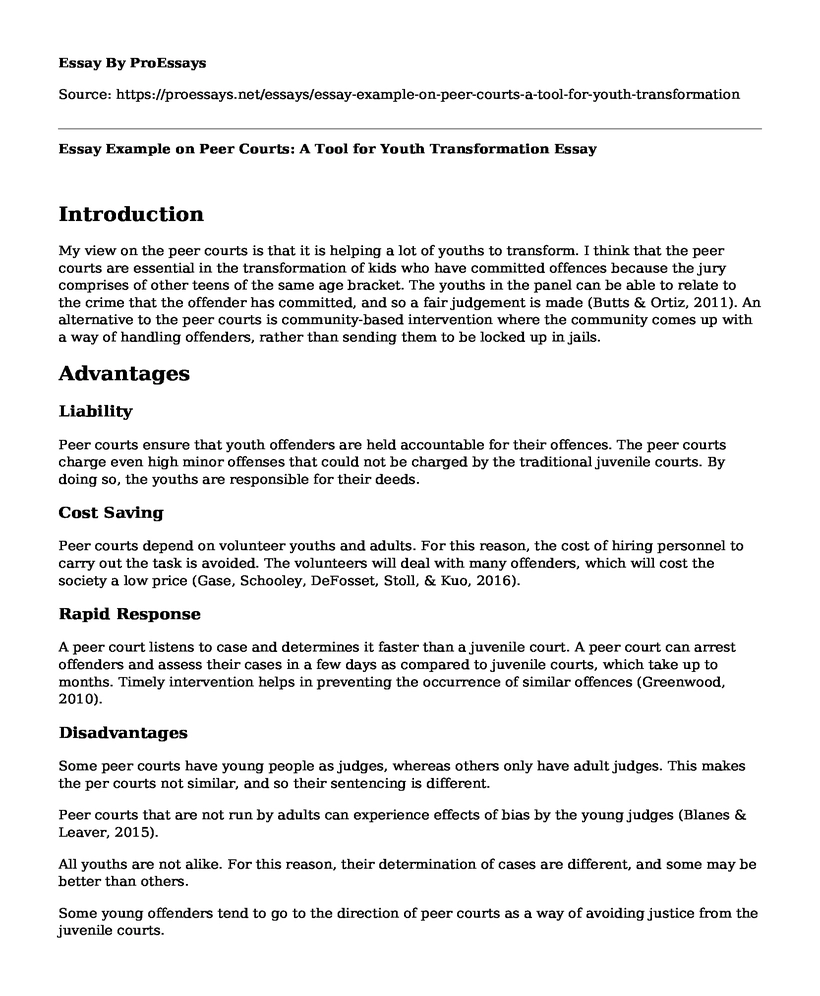Introduction
My view on the peer courts is that it is helping a lot of youths to transform. I think that the peer courts are essential in the transformation of kids who have committed offences because the jury comprises of other teens of the same age bracket. The youths in the panel can be able to relate to the crime that the offender has committed, and so a fair judgement is made (Butts & Ortiz, 2011). An alternative to the peer courts is community-based intervention where the community comes up with a way of handling offenders, rather than sending them to be locked up in jails.
Advantages
Liability
Peer courts ensure that youth offenders are held accountable for their offences. The peer courts charge even high minor offenses that could not be charged by the traditional juvenile courts. By doing so, the youths are responsible for their deeds.
Cost Saving
Peer courts depend on volunteer youths and adults. For this reason, the cost of hiring personnel to carry out the task is avoided. The volunteers will deal with many offenders, which will cost the society a low price (Gase, Schooley, DeFosset, Stoll, & Kuo, 2016).
Rapid Response
A peer court listens to case and determines it faster than a juvenile court. A peer court can arrest offenders and assess their cases in a few days as compared to juvenile courts, which take up to months. Timely intervention helps in preventing the occurrence of similar offences (Greenwood, 2010).
Disadvantages
Some peer courts have young people as judges, whereas others only have adult judges. This makes the per courts not similar, and so their sentencing is different.
Peer courts that are not run by adults can experience effects of bias by the young judges (Blanes & Leaver, 2015).
All youths are not alike. For this reason, their determination of cases are different, and some may be better than others.
Some young offenders tend to go to the direction of peer courts as a way of avoiding justice from the juvenile courts.
References
Blanes I Vidal, J., & Leaver, C. (2015). Bias in open peer-review: evidence from the English superior courts. The Journal of Law, Economics, and Organization, 31(3), 431-471. https://academic.oup.com/jleo/article-abstract/31/3/431/809473
Butts, J. A., & Ortiz, J. (2011). Teen Courts-Do They Work and Why? New York State Bar Association Journal, 83(1), 18-21. https://www.freewebs.com/northcountyteencourt/2011%20January%20NYSBS%20Journal%20Teen%20Courts%20-%20Do%20they%20Work%20&%20Why.pdf
Gase, L. N., Schooley, T., DeFosset, A., Stoll, M. A., & Kuo, T. (2016). The impact of teen courts on youth outcomes: A systematic review. Adolescent Research Review, 1(1), 51-67. https://link.springer.com/article/10.1007/s40894-015-0012-x
Greenwood, P. W. (2010). Preventing and reducing youth crime and violence: Using evidence-based practices. Sacramento, CA: Governor's Office of Gang and Youth Violence Policy. https://www.ncjrs.gov/App/Publications/abstract.aspx?ID=255934
Cite this page
Essay Example on Peer Courts: A Tool for Youth Transformation. (2023, Feb 11). Retrieved from https://proessays.net/essays/essay-example-on-peer-courts-a-tool-for-youth-transformation
If you are the original author of this essay and no longer wish to have it published on the ProEssays website, please click below to request its removal:
- Paper Example on Gun Laws
- Key Aspects of the Juvenile Case of Mary Bell - Paper Example
- Should There Be a Constitutional Amendment Banning the Death Penalty? Paper Example
- Criminal Justice and the American Bill of Rights Paper Example
- Essay Example on Criminal Justice, Intercultural Prejudice, and Employment Opportunities
- Essay Example on Terrorism/Threats: Illegal Violations to Coerce Populace & Affect Government Conduct
- Exploring Crime Through a Socio-Cultural Lens: Gender, Race, and Class - Essay Sample







